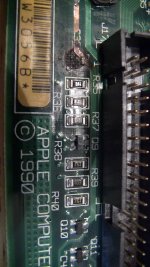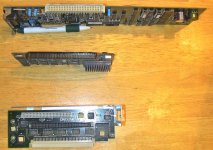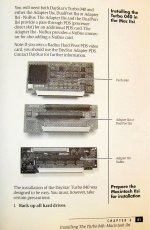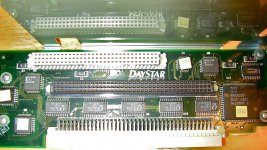DallasMacDude
New member
Hello to everyone in the group, I am new and I usually would comment a few times elsewhere before I posted a question, but this contains some info that I think some people might want to know about, especially if you own a Mac II of any variation and need to put a new drive in it.
I've been using Macs since I first purchased a new Mac SE with two 800k drives (no hard drive). I have collected many Macs over the years, some bought some given to me, others that used to be my main system which are now used for other reasons or are stored in a closet in my home. I was an Apple Student Rep while in college (here in Texas) and ran The Mac Help Center on Hotline for five years. So, I'm pretty knowledgeable about Macs, but of course there is a lot I don't know, too
The system I'm writing about is a Mac IIsi configured in several different ways. I'll have to give a little history to make things clear:
I had a IIsi, but it got water damaged (and rusted) without me knowing it. It was stored inside in a closet, but an old water jug that was in a box over it had some water in it that leaked and it rusted the mobo (thank you, wife). So, I bought another one off ebay. I got it and put a Daystar Turbo 040 in it (from my old computer) that had been stored in another location, it was working fine. The adapter card has a pass-thru nubus slot, which remained empty (at first). The hard drive that came with it was only 80 megs, so I decided to put a larger drive in it. The old hard drive from the other IIsi was broken (which is why it was stored) so I put a Seagate Barracuda (ST3218N) 2.1 gig hard drive in it. I had it configured to get it's termination from the computer bus and the termination enabled (via jumpers on the hard drive).
The computer wouldn't recognize the drive, no matter how I configured the jumpers, until I put an external scsi drive that had active termination. Then the computer booted and recognized the drive. I erased the internal drive and loaded 7.6.1 on it. When I took off the external drive, it wouldn't recognize the internal drive. So I put a passive terminator on the external scsi port, and that worked, it recognized the drive. Everything worked fine, for a couple days. I have no external drives or anything else connected to the computer, except for the keyboard and a monitor. After a couple days, I was using the computer and suddenly I smelled "magic smoke" coming from it and quickly turned it off. I examined the board and the internal scsi cable had burned through two wires on the left side (looking at it from the front of the computer). Also, one of the tantalum caps right under the cable was leaking fluid, and one of the tiny tantalum caps was completely burnt out. I have included a photo of the blown board below, but I tossed the cable so I don't have a pic of that. You can see in the photo that it stripped the green coating from the trace between one of the tantalum caps and the tiny cap (or is that a resistor?) on the board. The cable was burned right where it had been resting on one of the tantalum caps, so perhaps the cap burnt the cable instead of it being burned just by the voltage or amperage demands from the hard drive. The only thing I could figure was the hard drive was pulling too much power and had fried the cable and caps. I checked the voltage requirements on the Seagate and it was 5 volts, 650-850 milliamps. The original drive pulled 250-500. It didn't seem right that a couple hundred extra milliamps would do all that damage, but what else could it have been? I checked the drive to make sure it wasn't supplying termination power to the bus, and it was not configured to do so. So, I can only assume that the drive pulled too much power and burnt things out. I spoke with a friend who used to be a Mac repair tech and he said it shouldn't have done that, and mentioned something about passive termination vs active termination, but I couldn't find any manual for the ST3218N to see if it was active or passive term.
I went on ebay and found someone that had 8 new IIsi boards, sealed in anti-static bags for $28 a piece (yeah, it was awesome). I bought two, and they raised the price to $89 each. I guess when I bought two they thought they were worth more and raised the price. I received both boards and put one of the new boards into one of the IIsi's I have. This time I put the original Apple (Quantum) 40 meg hard drive back in. I put the Daystar Turbo 040 back in and put in an old Cabletron nubus ethernet card so I could trade files via Appletalk over ethernet. The computer was fine for a day or so. Then, suddenly, the monitor blinked and put up some lines and the computer was stuck. I restarted, no "bong" no nothing. The hard drive read for a while, but nothing. I tried resetting the PRAM, I unplugged and pressed the power button a few times, I pulled the PRAM battery, I pulled the Daystar card, I put in the stock RAM, I did everything and the computer just sits there. Nothing. I still have the owner's manual from the '040 board and there is no caution about an additional nubus board drawing too much current. It is made to hold two boards, the '040 and an additional nubus card (in this case, an ethernet board).
So, here are my questions:
1. Could a hard drive pull too much power and burn out the caps and do that to the SCSI cable?
2. Could the Daystar card and the ethernet card be pulling too much power and blowing out the board?
If anyone has any idea what could be going wrong, I would sure appreciate any help. Sorry for the length, but I thought it would be best to give all the pertinent information rather than people having to ask me for more information over and over. Thanks.

I've been using Macs since I first purchased a new Mac SE with two 800k drives (no hard drive). I have collected many Macs over the years, some bought some given to me, others that used to be my main system which are now used for other reasons or are stored in a closet in my home. I was an Apple Student Rep while in college (here in Texas) and ran The Mac Help Center on Hotline for five years. So, I'm pretty knowledgeable about Macs, but of course there is a lot I don't know, too
The system I'm writing about is a Mac IIsi configured in several different ways. I'll have to give a little history to make things clear:
I had a IIsi, but it got water damaged (and rusted) without me knowing it. It was stored inside in a closet, but an old water jug that was in a box over it had some water in it that leaked and it rusted the mobo (thank you, wife). So, I bought another one off ebay. I got it and put a Daystar Turbo 040 in it (from my old computer) that had been stored in another location, it was working fine. The adapter card has a pass-thru nubus slot, which remained empty (at first). The hard drive that came with it was only 80 megs, so I decided to put a larger drive in it. The old hard drive from the other IIsi was broken (which is why it was stored) so I put a Seagate Barracuda (ST3218N) 2.1 gig hard drive in it. I had it configured to get it's termination from the computer bus and the termination enabled (via jumpers on the hard drive).
The computer wouldn't recognize the drive, no matter how I configured the jumpers, until I put an external scsi drive that had active termination. Then the computer booted and recognized the drive. I erased the internal drive and loaded 7.6.1 on it. When I took off the external drive, it wouldn't recognize the internal drive. So I put a passive terminator on the external scsi port, and that worked, it recognized the drive. Everything worked fine, for a couple days. I have no external drives or anything else connected to the computer, except for the keyboard and a monitor. After a couple days, I was using the computer and suddenly I smelled "magic smoke" coming from it and quickly turned it off. I examined the board and the internal scsi cable had burned through two wires on the left side (looking at it from the front of the computer). Also, one of the tantalum caps right under the cable was leaking fluid, and one of the tiny tantalum caps was completely burnt out. I have included a photo of the blown board below, but I tossed the cable so I don't have a pic of that. You can see in the photo that it stripped the green coating from the trace between one of the tantalum caps and the tiny cap (or is that a resistor?) on the board. The cable was burned right where it had been resting on one of the tantalum caps, so perhaps the cap burnt the cable instead of it being burned just by the voltage or amperage demands from the hard drive. The only thing I could figure was the hard drive was pulling too much power and had fried the cable and caps. I checked the voltage requirements on the Seagate and it was 5 volts, 650-850 milliamps. The original drive pulled 250-500. It didn't seem right that a couple hundred extra milliamps would do all that damage, but what else could it have been? I checked the drive to make sure it wasn't supplying termination power to the bus, and it was not configured to do so. So, I can only assume that the drive pulled too much power and burnt things out. I spoke with a friend who used to be a Mac repair tech and he said it shouldn't have done that, and mentioned something about passive termination vs active termination, but I couldn't find any manual for the ST3218N to see if it was active or passive term.
I went on ebay and found someone that had 8 new IIsi boards, sealed in anti-static bags for $28 a piece (yeah, it was awesome). I bought two, and they raised the price to $89 each. I guess when I bought two they thought they were worth more and raised the price. I received both boards and put one of the new boards into one of the IIsi's I have. This time I put the original Apple (Quantum) 40 meg hard drive back in. I put the Daystar Turbo 040 back in and put in an old Cabletron nubus ethernet card so I could trade files via Appletalk over ethernet. The computer was fine for a day or so. Then, suddenly, the monitor blinked and put up some lines and the computer was stuck. I restarted, no "bong" no nothing. The hard drive read for a while, but nothing. I tried resetting the PRAM, I unplugged and pressed the power button a few times, I pulled the PRAM battery, I pulled the Daystar card, I put in the stock RAM, I did everything and the computer just sits there. Nothing. I still have the owner's manual from the '040 board and there is no caution about an additional nubus board drawing too much current. It is made to hold two boards, the '040 and an additional nubus card (in this case, an ethernet board).
So, here are my questions:
1. Could a hard drive pull too much power and burn out the caps and do that to the SCSI cable?
2. Could the Daystar card and the ethernet card be pulling too much power and blowing out the board?
If anyone has any idea what could be going wrong, I would sure appreciate any help. Sorry for the length, but I thought it would be best to give all the pertinent information rather than people having to ask me for more information over and over. Thanks.




